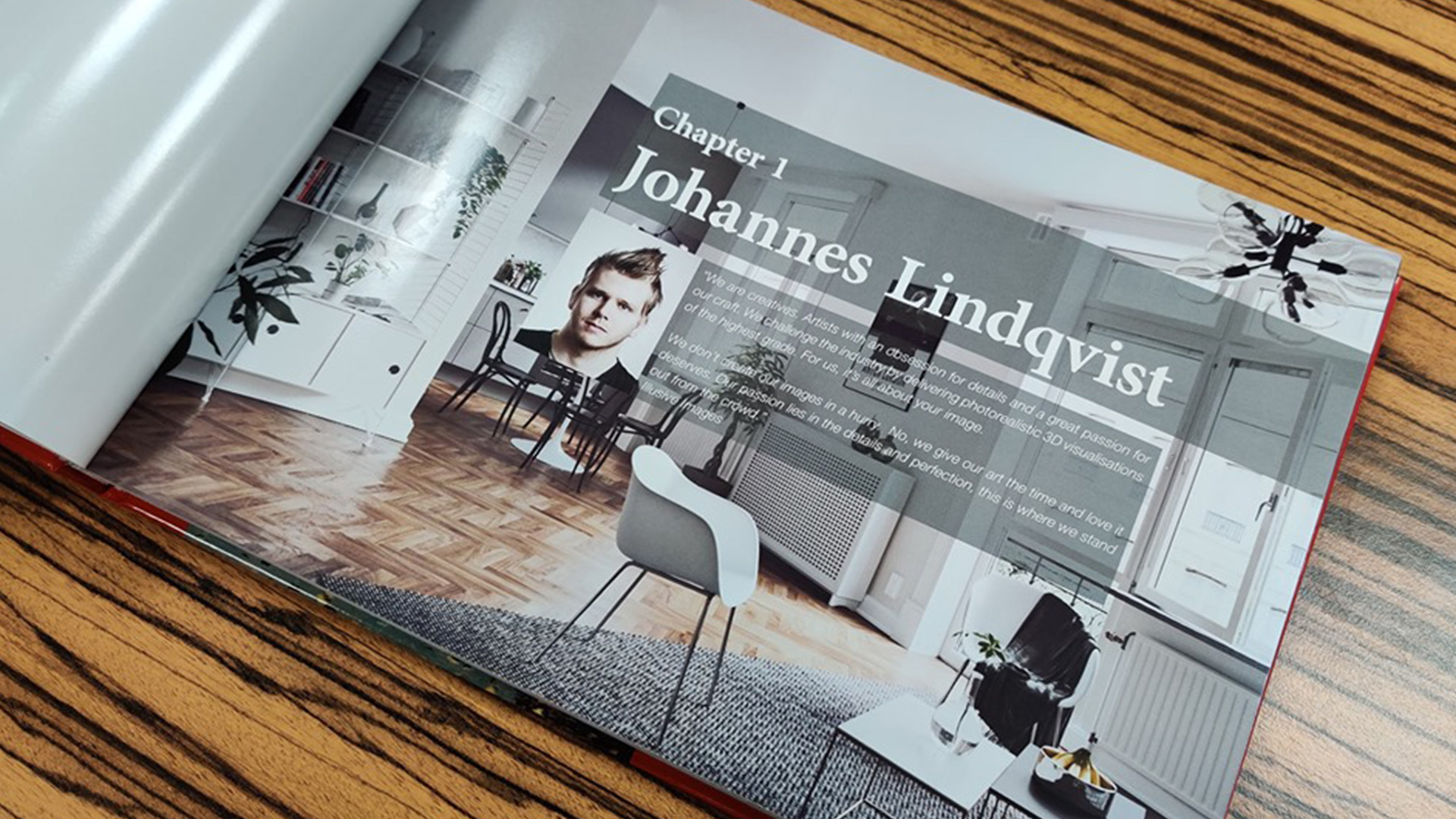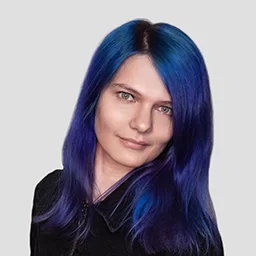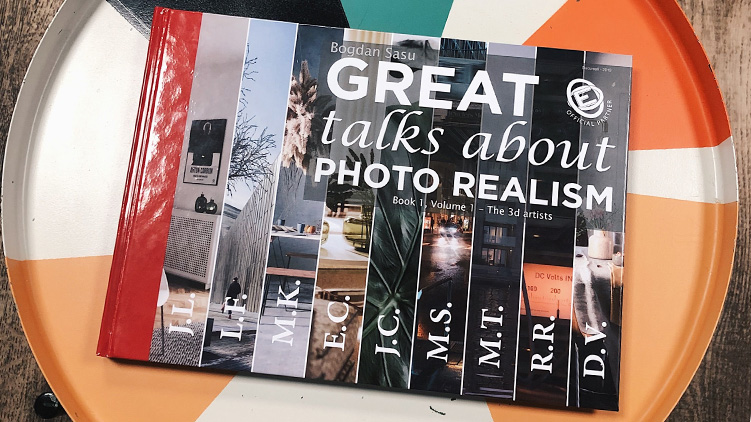How much blood, sweat and tears does it take to become an Archviz artist? How to deal with pitfalls along the way? What trends are emerging in the architectural CGI industry, and what does the future hold for it? Today, we will get the answers to all these questions from a person who knows the field of 3D architectural visualization from the inside out.

Bogdan Sasu is a seasoned CGI professional from Romania and the author of “Great talks about photorealism”. In this book, he shared stories of 9 world-renowned 3D artists and showed their amazing works. The purpose of the piece was to tell the wide audience about the secrets of creating photoreal renders. Written by a true enthusiast of 3D visualization, the book became an inspiration for aspiring artists and got great reviews in the CGI community.
We feel lucky that Bogdan found time in his busy schedule for an interview. So, without further ado, we invite you to read Bogdan’s story and get some insider knowledge about the Archviz world!
Hello, Bogdan! How did you get interested in Archviz and learn 3D visualization?
My personal interest in art began at an early age when all I had was paper and pencils. I liked coloring books and I spent my time trying to replicate the images. My family supported me along this journey, especially my father. He was the one to give me advice on how to draw. As time passed by, I became more and more passionate about art. In 2009, I was introduced to CGI. Realizing that those images were created on the computer, I got curious. My first step then was to learn 3Ds Max, which was my first 3D software.
In the period between 2009 and 2012, my thirst for knowledge in the field of CGI grew more and more, and I was pursuing my newfound passion. Going down the rabbit hole, I got interested in the work of Alex Roman and dreamt of reaching the same level one day. My ultimate goal was to achieve realism and to create absolutely photoreal images on the computer. Down the road, I got interested in various other programs such as Photoshop, Illustrator, InDesign, and many more. Trying to learn them was a full-time love-hate relationship. But things turned out ok in the end and learning how to use these programs served me well eventually.
3D and architecture could give me a purpose. CGI offers the opportunity to create worlds.
In 2015, I started working as an Archviz artist providing 3D interior design rendering services, both as an employee and as a freelancer. Being passionate about architecture and pursuing an education in this direction, I’ve sensed that 3D and architecture could give me a purpose; it offers the opportunity to create worlds. That feeling alone is intoxicating for an aspiring artist.
From 2017 to 2018, I was a part of TurboSquid, where I worked as a checkmate inspector. However, it was not for me. The whole routine thing does not suit me or my character. I started to seek out new challenges and projects. This was also a very busy time in my life, with me balancing a full-time and a part-time job, as well as several side projects. Due to some personal reasons, I had put myself into a state of mind where I wanted to hide behind my work. It was not a healthy thing to do in the long run.
There were many ups and downs along the road. However, the only thing that got me going was my will to succeed and do what others did not think about doing (or they simply did not have the vision for it). When others told me to stop, I kept going forward. I can say that it was a tough road but it was worth it. Nowadays, I’m able to mix business with passion on a daily basis.
Now, let’s talk about the pitfalls of working in Archviz. What are the challenges in collaboration between a 3D artist and an architect?
It’s really hard to say and it depends on a lot of things like experience, linguistic differences, work methodology, personalities. The real challenge is to find a way to communicate and to adapt to each other, so that trust can be made and the projects can reach their end in the best way possible. For example, with one of the designers that I work for (for a few years now), I had to explain the workflow to her, and it took patience from both sides to find a proper rhythm for our projects.

Architects and 3D artists need to find the best way to communicate.
So, some good communication skills are required. And what other skills should an Archviz artist have?
There are a few skills an Archviz artist should definitely have. The will and the ability to learn and constantly improve their knowledge is a must. Things are changing constantly and one must keep up with everything. How else if not by learning?
Patience is also a much-needed skill in this field. When I first started, nothing seemed easy. I wanted to achieve something unreal at that time. All I needed was time to figure things out, to learn and improve my abilities. However, Rome was not built in one day. My passion was my fuel but I needed the patience to get to where I am now. Trying to make perfect things seem imperfect is not an easy task. It needs time. It requires 1% talent and 99% sweat.
We are sure you keep up with everything new in the industry you work in. So, what are the current trends in architectural CGI?
From my perspective, as a 3D artist myself, I consider that virtual reality is ascending into something bigger. The new high-performance graphic cards will increase image quality, all because they are more suited for visual effects rather than what we used 10 years ago. Archviz will get to the point of unfolding right before your eyes, it will go GPU. This will sum up in a new batch of renders and artists. However, no matter where and how the result will be used, the work of the 3D artist will always be appreciated and sought after.

Archviz will get to the point of unfolding right before your eyes.
Also, lately, I have personally noticed a “going back to the roots” movement. By that, I mean that I had some clients who require sketches or watercolors instead of hyperrealistic visualizations. It came as a shock to me.
And how is the 2020 pandemic influencing the architectural CGI market?
This world-wide lockdown forced everything to go online. It was time for a change. The pandemic only made things go faster and made people realize the urge of turning to the online. In fact, we are getting used to seeing each other through a screen. The shopping is done online. But it is a struggle, as there are a lot of things to do in a short amount of time. And few people are willing to adapt to the change.
Are you currently working on some interesting projects? Tell us about them.
We currently have our hands full. Projects keep piling up on our desk due to the Covid-19 situation. As I already said, everything went online since the pandemic began. It was rather a necessity, not an option. As far as interesting goes, I can’t say that there is something out of the ordinary. As you know, some projects grow on you more than others, but that’s about it.
Currently, we are engaged in product rendering and residential projects, with particular designs and interesting concepts. Regarding residential projects, we feel that spherical renders offer a more detailed and somehow intimate view of the project, and we love the clients’ reaction when they see it. If you want, be sure to follow us on social media, where we will keep you updated.
How do you choose artists and projects for your books?
This is an easy one. Basically, I am interested in three things: the artist’s experience in the field, the impact he/she had in the community, and the portfolio. The specific order of these three is not important to me but each of them is a must. The artist’s experience will determine the quality of the product. This links the experience in the field as well as the portfolio in a way for people to understand and value the book at the end.

How are things going with “Great Talks about Photorealism”: Volume 2?
That is a very good question and a very personal one as well. The way I dreamt about this, all of it would have gone smoother. Initially, things went 80% as planned, and everything was on track, with the usual challenges of time management, final editing, and so on.
The plan was to release it on the 1st of July, like the first Volume. But the pandemic forced us to postpone it. And when things seemed to calm down, we had another unpleasant surprise: one of the artists decided to leave the project. It was pretty hard to explain to those who pre-ordered the book that we needed to make another delay. However, we announced this via email, and people were pretty supportive. It gave us fuel to carry on facing a new challenge: which artist to include and how to re-launch the book so that the new artist will not feel he/she is just a number to fill the blank chapter.
Things are still in the “figure out” mode mostly but we promise to deliver an even better book given the time we had to prepare it!
What motivates and inspires you the most?
Pure obstinacy and passion for art. These sum up my essence as a person and a man of vision. While many people around me told me I would fail, I kept going, I walked in the opposite direction and achieved my dream.
Around 2009, Alex Roman released a video called “The third and seventh”. That video was life-changing for me. It was my starting point, my energy drink, and my fuel for years to come. It is still one of the most impressive ones to me.
While many people told me I would fail, I kept going and achieved my dream.
What is the best and worst decision you’ve ever made?
Funny you should ask that. For me, it is one and the same. The worst decision was at the same time one as the very best: never give up. If I had given up, none of these would have been achieved. The community, the people I have met along the way, the ups and downs nor the book. It was all worth it in the end. Doing what you dream of as a child is a dream come true for many people. For me, a little boy growing up with pencils and paper, it is living my dream.
What is the best piece of advice you have ever received?
Whatever you do in life, do it great and never let people down!
We are grateful to Bogdan for this insightful talk and useful advice. And, of course, we loved to discover his personal story of becoming a professional 3D artist. We wish Bogdan great success in his ongoing and future CGI projects.
Want to learn how much your project costs? See how we evaluate 3D rendering projects
Hope this interview was inspiring and helped you to learn something new about the present and future of the Archviz industry as well as a 3D artist’s path. If you got ideas on whom to interview next or questions you want us to address – please don’t hesitate to write in the comments below. Stay with us for more interesting news and stories right from the heart of Archviz.

Catherine Paul
Content Writer, Editor at ArchiCGI
Catherine is a content writer and editor. In her articles, she explains how CGI is transforming the world of architecture and design. Outside of office, she enjoys yoga, travelling, and watching horrors.




